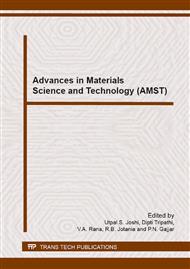[1]
V. L. Colvin, M. C. Schlamp and A. P. Alivisatos, Light-emitting diodes made from cadmium selenide nanocrystals and a semiconducting polymer, Nature 370 (1994) 354-357.
DOI: 10.1038/370354a0
Google Scholar
[2]
M. Batzill and U. Diebold, The surface and materials science of tin oxide, Prog. Surf. Sci. 79 (2005) 47–154.
Google Scholar
[3]
T. E. Oling, J. Fraysse, J. P. Travers, A. Dufresne and A. Pron, Highly conducting and solution-processable polyaniline obtained via protonation with a new sulfonic acid containing plasticizing functional groups, Macromolecules 33 (2000) 2107-2113.
DOI: 10.1021/ma991525i
Google Scholar
[4]
R.Ansari, and M. B. Keivani, Polyaniline conducting electroactive polymers: thermal and environmental stability studies, E-Journal of Chemistry 3 (13) (2006) 202-217.
DOI: 10.1155/2006/395391
Google Scholar
[5]
M. Vecino, Synthesis of polyaniline and application in the design of formulations of conductive paints, Polym. Adv. Technol. 15 (2004) 560–563.
DOI: 10.1002/pat.502
Google Scholar
[6]
S.Ameen, M. S. Akhtar, S. G. Ansari, O. B. Yang, and H. S. Shin, Electrophoretically deposited polyaniline/ZnO nanoparticles for p-n heterostructure diodes, Superlattices Microstruct. 46 (2009) 872-880.
DOI: 10.1016/j.spmi.2009.09.007
Google Scholar
[7]
J. Zhu, Polyaniline-tungsten oxide metacomposites with tunable electronic properties, J. Mater. Chem. 21 (2011) 342–348.
DOI: 10.1039/c0jm02090g
Google Scholar
[8]
D. Kanjijal, Swift heavy ion-induced modification and track formation in materials, Curr. Sci. 80 (2001) 1560–1566.
Google Scholar
[9]
M. Toulemonde, C. Dufour and E. Paumier, Transient thermal process after a high-energy heavy-ion irradiation of amorphous metals and semiconductors, Phys. Rev. B: Condens. Matter. 46 (1992) 14362–14369.
DOI: 10.1103/physrevb.46.14362
Google Scholar
[10]
B. Scrosati, Applications of Electroactive polymer, Chapman and Hall, London, 1993.
Google Scholar
[11]
Y. Q. Wang, M. Curry, E. Tavenner, N. Dobson, and R. E. Giedd, Ion beam modification and analysis of metal/polymer bi-layer thin films, Nucl. Instrum. Methods Phys. Res., Sect. B, 219–220 (2004) 798–803.
DOI: 10.1016/j.nimb.2004.01.166
Google Scholar
[12]
N. F. Mott, Conduction in glasses containing transition metal ions, J. Non-Cryst. Solids, 1 (1968) 1-17.
DOI: 10.1016/0022-3093(68)90002-1
Google Scholar
[13]
M. Pollak and G. E. Pike, AC conductivity of glasses, Phys. Rev. Lett., 28 (1972) 1449-1451.
DOI: 10.1103/physrevlett.28.1449
Google Scholar


